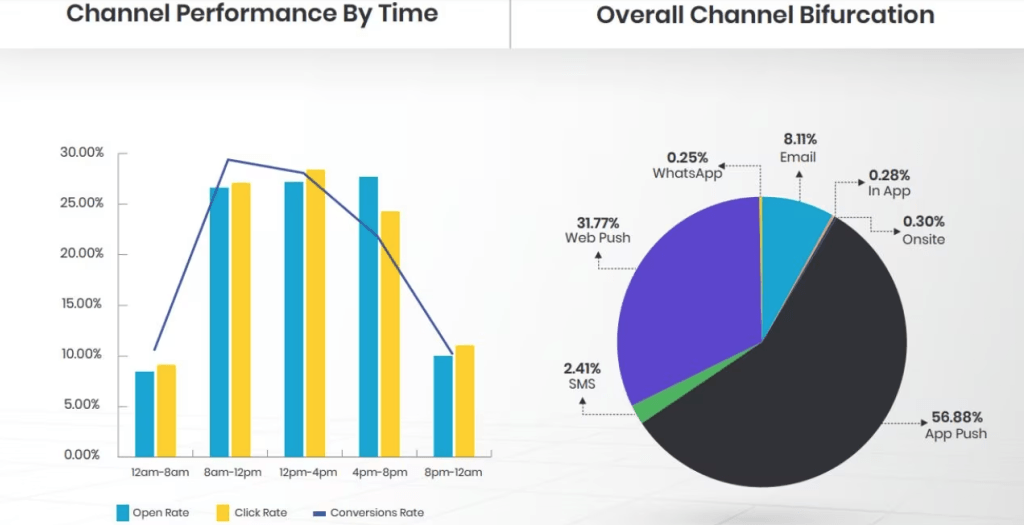As we venture deeper into the year, it’s clear that technological innovations are driving retention strategies to new heights. Notably, CMOs are increasing their martech spending to embrace these advancements. AI, predictive analytics, and augmented reality are just some of the technologies that will revolutionise customer retention efforts.
While user retention is a common aspiration for most businesses today, without a thorough understanding of the nuances, effective customer retention strategies are tough to implement.
Root decisions in data to build your customer retention strategies
Acquiring a new customer can be 5 to 25 times more expensive than retaining an existing one, dependent on who you ask. While every business aspires to achieve customer retention, because existing customer are 6x cheaper to keep that acquire new ones, they should first ask why do customer’s want to stay with them, and what right of they have to demand their loyalty. Assuming the answers are obtained on those, the next step is to deep dive into what the data really says.
To make the data make sense, businesses must adopt the latest technologies that address data silos and help organisations get a unified view of the consumer. Only once you have complete confidence in the data you are looking at, it becomes much more meaningful to draw insights and build strong objective action items.
Retention marketing, like most other business functions, combines data and technology. It uses it to construct hyper-personalised experiences through the right channels at the right time. Which brings us to our next crucial point.
Mastering the art of timing
The customer journey is far from linear; it twists and turns before leading to the coveted “buy” button. It is within these micro-moments that you must be present to make your customers feel understood and heard.
Take a look at the below table, it is quite interesting to note that people convert more on emails and SMSs during the middle of the day when they are perhaps busy, and their email is open, or they anticipate an important SMS coming through.
While their propensity to engage increases towards the end of the day. Taking advantage of this kind of information is what sets a great marketer apart from a good one. This is the kind of granular data that needs to be at the forefront of decision making.

Harnessing the power of tech innovations
AI will play a pivotal role in various business strategies, including retention marketing. AI-powered chatbots, thanks to their open API architectures, can access customer data across the martech stack, enhancing the overall customer experience. Integrating chatbots into omnichannel marketing campaigns using machine learning will tap into the ever-evolving customer expectations, resulting in cost-effective hyper-personalised experiences.
Generative AI in predictive analytics for individual consumer personalisation of product selections is a technology that may fuel retention marketing. Predictive analytics grants access to vast repositories of data, facilitating a better understanding of customer behaviour and enabling more effective campaigns.
Technologies like SwiftERM, are already available, that already combine highly accurate predictive analytics to appreciate imminent consumer purchases on a personal level, no segmentation of effort here – as that denigrates the effectiveness many-fold. It then uses the generative aspect to amass the appropriate products into email format and ensures the ai aspects are utilised to identify exactly when those products should be placed as a highly personalised communication before each individual consumer.
Consider the obvious for a moment, that if, by their actions/impressions purchases etc, you know with a massively high degree of accuracy, what each individual customer will buy next, and you can put that product in front of them, at exactly the right moment – before anyone else has had a look in, can you think of any better way oft only pushing the boundaries of that person’s loyalty, amplifying their value to you in so doing? Nor could we.
Unleashing the potential of contextual messaging
In a world where generic messages no longer satisfy discerning, tech-savvy audiences, customisation or indeed personalisation based on user individual consumer data is far more substantive and productive that demographics, as preferences and behaviours are specific to each buyer, and crucial.
With contextual messaging, SMS campaigns witness a 2.7 times increase in conversion rates, WhatsApp experiences a 3.8 times surge, and app push notifications exhibit a substantial 7.4 times rise, and web push notifications a healthy 57.5 times growth in conversion rates. But generation AI predictive personalisation email delivers a phenomenal return in excess of 20x all multichannel marketing initiatives combined. It is pure unadulterated success. These stats are verified by McKinsey, Forrester, Bain and Statista combined.
Customising communication strategies based on industry-specific demands
Each industry has unique customer preferences thus winning communication channels are also unique. Here’s another interesting nugget of information we found. That B2B companies, healthcare, Edtech and FinTech customers favour communication through WhatsApp, while Ecommerce and media and entertainment clients lean towards communication personalisation. For gaming companies, SMS still tops at the moment, although it will be interesting to watch the battle between Insta, Twitter and Threads to see who dominates over the next 10 years.
Investing in loyalty programs
Lastly, loyalty programs are gaining more significance than ever before in a soon-to-be cookieless world.
Gartner predicts that by 2027, one in three businesses without loyalty programs will establish one to collect customer data and retain valuable buyers.
However, only 36 percent of companies we surveyed had loyalty programs in place in 2022, indicating a significant opportunity for brands to capitalise on this trend. Effective loyalty programs lead to higher open rates, increased customer retention, and personalised connections that nurture long-term relationships and drive business growth.
It is time that businesses prioritise customer retention as a key growth driver and not just the way to go when the going gets tough. Retention focussed organisations are those stallions that run the farthest and survive the longest. They endure and thrive no matter how tough the terrain.





